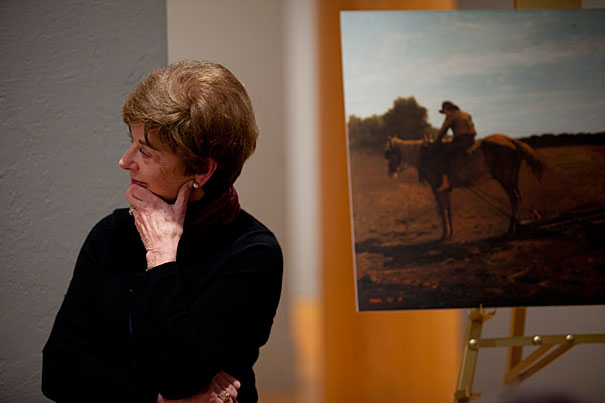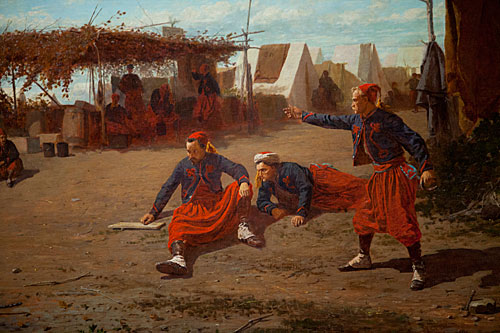
Senior museum educator Judith Murray (pictured) helped develop the Engaging New Americans project at the Harvard Art Museums. It’s designed to introduce immigrants to American culture, and to show “how works of art really speak,” she said. “The Brush Harrow” is a frequent centerpiece of the classes.
Stephanie Mitchell/Harvard Staff Photographer
Winslow Homer’s Civil War
Gallery talk covers works of respite and angst
American artist Winslow Homer (1836-1910) — the self-taught master best known today for his scenes of nature and the sea — got his start as one of the “special artists” of the Civil War. They were the combat correspondents of their day, traveling and living with soldiers. Their sketches, woodcuts, and paintings showed both the horror of battle and the makeshift respite of camp life. Printed by the thousands, these images gave the American public a visual sense of the war.
Homer grew up in what was then rural Cambridge, and by 1859 had a studio on 10th Street in New York. In March 1861 he was hired by Harper’s Weekly to illustrate Abraham Lincoln’s first inaugural address — and then stayed on with the magazine when the Civil War began a month later. Off and on, Homer spent the next four years documenting the conflict. (For a time he was attached to the 5th New York Infantry, a unit known as Duryee’s Zouaves.) He sketched a war of action, color, and carnage — but he didn’t ignore the lulls in between, when soldiers lounged in camp thinking of home.
Homer’s Civil War days, represented by two paintings, drew a small, intent audience to the Arthur M. Sackler Museum last week. The occasion was the latest in a series of gallery talks sponsored by the Harvard Art Museums. Melissa Renn, senior curatorial associate, and senior museum educator Judith Murray provided commentary on the two works: “Pitching Quoits” and “The Brush Harrow.”
Both are dated 1865, but could hardly be more different. The first depicts Zouave soldiers — resplendent in their trademark red fezzes, short jackets, and billowing scarlet pants — pitching quoits in a crowded Army camp. (They were actually pitching horseshoes, said Renn.) The painting’s dramatic use of color marks it as a Homer, Renn said, and its composition shows both romantic and classical influences.

The second painting shows two boys, one mounted on a U.S.-branded horse drawing a harrow across a barren field. That they were boys, that there were no men, and that the scrawny horse had seen Army service are all oblique acknowledgements of the exhausting war that had just ended. Critics recognize this outwardly peaceful scene as a Civil War painting as much as any battle scene could be — and that it is tender, sensitive, and poignant. To Murray, this rural scene embodies Lincoln’s wish in his second inaugural — that Americans set aside malice and “bind up the nation’s wounds.”
It also shows, she added, “the presence of the absence” — a scene that speaks to a fact of life following the war. It was an immense killing field, with a death toll of 750,000.
Murray helped develop the Engaging New Americans project at the Harvard Art Museums. It’s designed to introduce immigrants to American culture, and to show “how works of art really speak,” she said. “The Brush Harrow” is a frequent centerpiece of the classes.
In his Civil War work, said Renn, Homer never depicted dead soldiers — a commonplace otherwise in newspapers of the time. Nor did Homer depict battle scenes as heroic.
But he was not shy about the facts. Perhaps his best-known illustration from the war is “The Army of the Potomac – A Sharp-Shooter on Picket Duty” (1862). It depicts a Union sniper poised in a tree and peering through a scope mounted on his long rifle. Art historians praise it for its “dramatic diagonals,” said Renn. But to Homer it was a tragedy, and sharpshooters were the grim technicians of modern rifle technology. “I always had a horror,” he wrote later, “of that branch of service.”
There is a touch of horror even in the outwardly peaceful “Pitching Quoits,” one viewer suggested this week. In the foreground, speckled on scrap wood near a dead campfire, are holly berries, tiny and blood-red.
Upcoming, “Feininger in the Darkroom,” a two-point perspective gallery talk, Arthur M. Sackler Museum, 485 Broadway, Cambridge, from 3:30 to 4:30p.m., April 18. For additional information or upcoming talks, visit the website.




